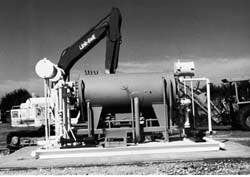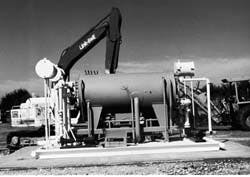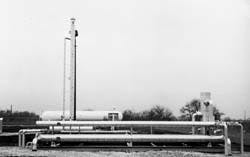LITHIUM BROMIDE ABSORPTION CHILLER PASSES GAS CONDITIONING FIELD TEST
Mark J. Lane, Melton A. Huey
Nicol & Associates
Richardson, Tex.
A lithium bromide (LiBr) absorption chiller has been successfully used to provide refrigeration for field conditioning of natural gas.
A field test co-funded by the Gas Research Institute (GRI), Chicago, and EnMark Gas Gathering Co., Dallas, combined current technologies used in natural-gas processing and in commercial air conditioning.
Among other findings were that operating and maintenance costs were less than $0.0164/Mcf.
Nicol & Associates, Richardson, Tex., provided engineering services to design, implement, and evaluate the project. The field test was conducted at EnMark's gas-gathering facilities in Grayson County, Tex.
The intent of the study was to identify a process that could provide a moderate level of refrigeration necessary to meet the quality restrictions required by natural-gas transmission companies, minimize the initial investment risk, and reduce operating expenses.
The technology in the test proved comparatively less expensive to operate than a propane refrigeration plant.
Volatile product prices and changes in natural-gas transmission requirements have created the need for an alternative to conventional methods of natural-gas processing.
RICH GAS STREAMS
During the late 1980s, declining product prices and high operating expenses forced many natural-gas processing plants to shut down. This created operational problems in pipelines that as a result were transporting richer gas streams.
Condensed liquids accumulating in gathering systems and distribution lines caused an increase in operating pressures and maintenance costs. These liquids also had the potential to damage equipment due to liquid carry-over.
Many natural-gas transmission companies began to impose new restrictions on the quality of natural gas acceptable for transporting. These restrictions included BTU content or dew point limitations to reduce operational problems.
Natural-gas producers faced processing tosses or shut-in production until market conditions became more favorable. EnMark was faced with this dilemma as a result of contract renegotiations.
GRI funded a preliminary study to evaluate current refrigeration technology and identify a process which could economically provide a minimum level of refrigeration. The requirements (if this process were to remove only enough condensable liquids to meet contractual obligations.
The investment required for current methods of natural-gas processing, designed as they are for maximum liquid recovery, could not be justified for this application.
Nicol conducted the preliminary study which included an evaluation of propane refrigeration, LiBr absorption, and ammonia absorption chillers.
The LiBr absorption chiller was selected based on the following potential advantages: low operating expense, waste-heat utilization, proven technology, no hazardous by-products, and commercial availability.
Typically, LiBr absorption chillers are used in commercial air conditioning, ranging in size from 100 to 1,500 tons. The refrigeration capacity of a normal 100-ton unit can vary from 16 to 159 tons, depending upon the temperature available for the hot water and cooling-water systems and the required chilled water temperature.1
This equipment is most commonly operated at an average temperature of 46 F. for only a few months during each year. Therefore, one of the main objectives of the project was to determine if the chiller could be maintained and operated continuously in an oil and gas field.
GAS CONDITIONING
A standard Trane Co. 100-ton LiBr chiller with a modified control system was installed (Fig. 1) to provide the refrigeration portion of the gas-conditioning process. Other components necessary to complete the operation of the chiller included a cooling tower, heat source, and three closed-loop water circulation systems (Fig. 2)(74931 bytes).
A series of heat exchangers cool the gas stream, removing only the condensable liquids necessary for hydrocarbon dew point control. The gas-conditioning facilities include a gas/gas exchanger (EX-2 in Fig. 2), a gas/chilled water exchanger (EX-3), a gas/product exchanger (EX-4), and a cold separator (Fig. 3).
Inlet gas enters the gas/gas exchanger at 600 psig and 85 F. and is cooled to 50 F. while heat is rejected to the residue gas. The gas/chilled water exchanger cools the stream to approximately 40 F. as heat is absorbed by the chilled-water system from the LiBr chiller.
Product from the cold separator cools the gas stream an additional 1 or 2 F. through the gas/product heat exchanger. The product is stabilized and stored in a 30,000-gal pressurized tank. The stabilizer overhead gas is returned to the inlet-compressor suction.
Residue gas absorbs heat from the inlet gas stream (EX-2) and flows to sales at 590 psig and 75 F. with a hydrocarbon dew point 38-40 F.
A major benefit in this particular refrigeration process is its ability to use waste heat. For the field test, a plate-fin heat exchanger (EX-1) was used to recover waste heat from the engine jacket water system of a 450-hp compressor package.
Hot water from this system enters the concentrator at 100 gpm and 190 F. Other sources of waste-heat, such as engine exhaust, may also be used to increase the hot-water temperature as needed.
Programmable proportional integral differential controllers were selected to control the amount of heat supplied by the hot-water system and rejected by the cooling-water system. An elaborate monitoring and data-acquisition system was installed to document properly the plant and chiller performance.
A total of 27 temperatures, 9 pressures, and 8 flow rates were monitored continuously by a remote terminal unit (RTU). The RTU polls and converts each signal to a digital reading at 1-min intervals and sends the data to a personal computer via an RS-232 serial port.
A software program was developed to average the readings; calculate loads, flow rates, and efficiency; and store the data. The process data were downloaded via modem and could be imported into a spreadsheet.
LITHIUM BROMIDE
ABSORPTION
Water is the refrigerant in the absorption chiller because it boils easily at a low evaporation pressure, has a relatively high refrigeration effect, and is easily separated from LiBr when the solution is boiled.
LiBr is used as the absorbent because it has an exceptional affinity for water vapor, releases the water vapor at relatively low temperatures, and has a boiling point much higher than water.
The four basic sections of an absorption chiller are split into a high-pressure area and a relatively low-pressure area, although all are operated in a vacuum (Fig. 4)(80800 bytes).
The concentrator and condenser form the high-pressure side, while the evaporator and absorber form the low-pressure side. Pressure in the high side is approximately 10 times greater than the low side.
Energy from a waste-heat source is used to heat a water stream. The hot water moves through the concentrator tubes and causes the dilute LiBr solution to boil. The refrigerant, as water vapor, is released from the LiBr solution as it boils.
Water vapor then passes from the concentrator to the condenser. Cooling water flowing through the condenser tubes cools the water vapor which causes the vapor to condense. The condenser operates at a vacuum, usually at a pressure of approximately 1.0 psia and a temperature of 90 F.
The condensed refrigerant falls to the condenser pan and is directed into the evaporator section through an orifice. As the condensed refrigerant (water) passes through the orifice into the lower pressure evaporator section, usually at 0.1 psia and 37 F., a portion flashes to vapor, causing the temperature of the remaining liquid refrigerant to drop.
The heat from a closed circulating water stream is used to vaporize the water in the evaporator section. The corresponding heat of vaporization "chills" the circulating water stream, which is the medium used to chill an external load.
The resulting water vapor is then drawn into the relatively lower pressure absorber section and is absorbed into a concentrated aqueous solution of LiBr. Cooling water is circulated through the absorber-tube bundle in order to remove the heat of absorption from the LiBr solution.
The concentrated LiBr that is sprayed over the absorber tubes absorbs the water vapor and then becomes diluted, reducing its ability to absorb. The dilute solution is then returned to the concentrator to reclaim the refrigerant, thus completing the cycle.2
The cooling-water system was designed to provide 400 gpm of cooling water entering the chiller at 85 F. and to reject approximately 880 MBTU/hr.
Originally, the temperature of the chilled water leaving the chiller was to be maintained at 40 F. Since installation of a modified control system, however, the chilled-water temperature has been successfully maintained at 38 F. This is well below the manufacturer's recommended limit of 42 F.
The chilled water design rate was 150 gpm.
The primary point of temperature reduction for hydrocarbon dew point control is through the gas/chilled-water heat exchanger. The chilled-water temperature is maintained at 38 F. in order to cool the gas stream to approximately 40 F.
The inlet-gas stream conditions, such as temperature, pressure, and volume, may change and cause the cooling requirements of the chilled-water system to vary as well as the heat requirements of the other systems within the chiller.
For instance, a decrease in the gas volume decreases the temperature differential between the chilled water entering and leaving the chiller, therefore less cooling is required to maintain 40 F.
To control temperature and maintain heat balance within the chiller, the cooling water and hot water volumes are adjusted according to load requirements. In the test, this was accomplished by automation of the operation of the bypass and throttling of valves for the cooling water and hot-water systems.
A patent has been issued on this control philosophy with a second patent pending.3
ECONOMICS
The initial economic study of the field gas-conditioning project was conducted in the spring of 1990.
At that time, the margin between liquid product and natural-gas prices was very small and an investment in a processing plant would not pay out. The project was therefore evaluated as an amine plant based on the cost incurred by the producer to condition or process the gas.
The cost to condition or process the gas was calculated by dividing the profit or loss on the investment by the total volume of gas processed in year 5 of operation.
The producer cost was based on the following parameters:
- Estimated capital investment, operating, maintenance, and labor cost for each plant
- Average Mont Belvieu product prices for the period of June 1989 through May 1990.
- $1.85/MMBTU gas price
- Transportation and fractionation fees of 7/gal for LiBr gas-conditioning plant and 6/gal for propane refrigeration plant
- 10% production decline
- 5% escalation rate on gas price, product price, operating and maintenance cost, and labor cost.
The initial study included a comparison and evaluation of producer cost between a LiBr plant operating at 40 F. and standard propane refrigeration plants operating at 40 F. and -30 F. Fig. 5 (77834 bytes) shows how the producer cost to condition or process gas varied as gas and product prices fluctuated from 1990 to 1994.4 5
Average product prices increased as gas prices declined during 1991 following the Iraqi invasion of Kuwait indicating an investment in a -30 F. propane plant would have been considerably more profitable than the LiBr plant due to higher recovery rates, however only temporarily.
In 1992, prices for natural gas increased and product prices declined, resulting in a questionable investment for any of the plants.
The average natural-gas price for 1993 rose to exceed the initial study price as product prices continued to decline.
By 1994, prices had come full circle with natural gas averaging nearly the same as the initial study while product prices had declined to near pre-Gulf War levels returning the producer cost to 1990 levels.
Based on historical trends, the economic factors used to evaluate an investment for a natural-gas processing plant should be determined case by case. Current market conditions and long-term objectives must also be considered to select the type of process best suited for each application.
Because none of the plants would pay out, when faced with the alternative of shutting-in gas production, the LiBr chiller plant was the best alternative because it cost the producer less to operate.
PERFORMANCE
The LiBr absorption chiller was originally designed to provide approximately 25 tons of refrigeration capacity with an inlet gas volume of 10 MMcfd. Because of contract changes and reduced drilling plans, however, gas flow to the plant averaged 4.561 MMcfd which necessitated less refrigeration capacity.
Inlet-gas analyses indicated an average of 2.3 gal/Mcf C3+ and 1,170 BTU/cu It, which was considered relatively lean. Actual liquid recovery was measured to be 0.31 gal/Mcf, as predicted by process simulators.
Residue gas was maintained at or less than the 40 F. hydrocarbon dew point specification daily. Chilled-water temperatures only fluctuated slightly during significant changes in the load.
With the modified control system, the chilled-water temperature was maintained within 1 F. of the set point even during significant changes in ambient temperature (Fig. 6).
In order to test the chiller performance, additional load was generated by manual bypassing of the gas/gas exchanger. The inlet-gas temperature to the gas/chilled-water exchanger was increased from the design point of 55 F. to approximately 80 F.
Test loads varied from 17.8 tons with a chilled-water temperature of 42 F. to 21.85 tons with a chilled-water temperature of 36 F. The chiller could not be fully loaded because of the reduced gas volume.
Originally, chilled-water temperatures less than 38 F. could not be maintained without manual adjustment of the cooling water and hot-water flow rates. Testing indicated, however, that a chilled-water temperature of 36 F. may be achieved and maintained with the patented control system.
During the last 9 months of the test period, the gas-conditioning facility was continuously operated with less than 1% downtime with no downtime attributable to the LiBr absorption chiller.6
O&M COSTS
Total operating, maintenance, and fuel costs was $27,900 for the first year of operation. This included consumables, contract labor, fuel to provide electrical power, maintenance, and an average of 1.5 hr/day labor to operate the facility.
Based on the average flow rate of 4.651 MMcfd, the operating, maintenance, and fuel cost was $0.0164/Mcf. A comparable propane refrigeration plant could have operating expenses in the range of $0.06/Mcf to $0.08/Mcf.1
The field test of a LiBr absorption chiller in gas conditioning service verified the following:
- The hydrocarbon dew point can be maintained at or below 40 F.
- Operating and maintenance costs are less than $0.0164/Mcf for this application.
- This process provides moderate refrigeration and maximizes BTU content of the residue-gas stream.
- Commercially available equipment with control modifications is suitable for operation in an oil and gas field environment.
- The units emit no pollutants, generate no hazardous waste, and require no special permits.
GRI has entered into a licensing agreement with Nicol which is evaluating other areas in the natural-gas industry for the LiBr chiller technology. In addition to field gas conditioning, potential applications include plant inlet temperature control and turbine inlet air cooling.
A standard design is being developed for 100, 500, and 1,000-ton LiBr chiller packages.
REFERENCES
- ABS- DS-1, Single Stage Absorption Cold Generator (March 1989). The Trane Co. Commercial Systems Group, LaCrosse, Wis.
- ABS-M-2A, Operation, Maintenance, Single Stage Absorption Cold Generator (June 1993). The Trane Co. Commercial Air Conditioning Division, LaCrosse, Wis.
- U. S. Patent No. 5,315,839: Control System for Absorption Heat Transfer Plants (May 31, 1994). Donald V. Nicol, Russell A. Kilbourn, and Mark J. Lane.
- Spot gas prices. Source: Natural Gas Clearinghouse in Oil & Gas Journal, third issue of each month.
- Natural Gas Liquids Prices. Source: Gas Processors Report, Oil & Gas journal, third week of each month.
- Field Gas Conditioning Using Lithium Bromide Absorption Chillers. GRI Gas Processing Bulletin. August 1994. Chicago: Gas Research Institute.
- Gas Processing Industry: Lower-48 States, Topical Report (revised July 1991); No. GRI-91/0232, pg. 32. Chicago: Gas Research Institute.
Copyright 1995 Oil & Gas Journal. All Rights Reserved.




